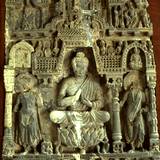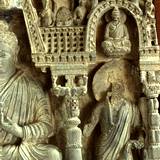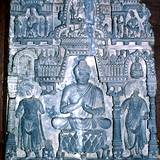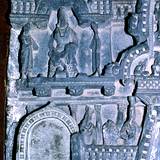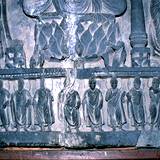2
Triad and other characters within aedicula with double row of gandharan-persepolitan columns, raised segmental trapezoidal architrave with balcony at the sides, supported by brackets with leonine protomes, section of four-sided curved sloping roof and dome, resulting in a pseudo-trefoil arch, with aediculae at the sides, with raised segmental trapezoidal architrave, four-sided curved sloping roof and dome, with balconies; figured base.
In the centre Buddha in dharmacakramudra, with arm and right shoulder exposed, on a lotus with jewel-like stem, supported by two small kneeling figures; at the two sides, two standing haloed Bodhisattvas: the one in the right with uttariya covering his left side, jewels, brahmanical cord, with garland; above his halo, a Buddha in dhyanasana on a lotus, probably originally paired by a similar one (now missing) on the opposite side.
On the fields of the pseudo-trefoil arch: below: the Great Renunciation; above: the Great Departure, seen frontally.
Inside the two smaller aediculae above: Bodhisattvas seated on wicker lattice stool, the one on the right in pensive attitude, with turban, garland in the left hand (maybe Avalokitesvara); the other on the left with cross ankles, without turban (?), with attribute in the left hand (?) (maybe Maitreya); at the sides of both the Bodhisattvas: devotees in anjalimudra.
In the balconies: devotees, some of them in anjalimudra
On the base: the seven Buddhas of the past and Maitreya (on the right), with devotees
Wealth of architectural decorative details: gandharan-persepolitan columns with base supported by winged atlas, decorated shafts, decorated zoomorphic capitals, and of the mixed type, with gandharan-corinthian capitals; decorated brackets with leonine protomes; volutes of the pseudo-trefoil arch in the form of peacock heads
Identified by some as the Amitabha’s paradise (Sukhavati)

